
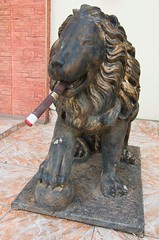
After a night in the high hills of the Miraflor area outside Esteli, we returned by bumpy bus for a very quick shower and breakfast before heading to Esteli’s cigar factory for a tour. It was really interesting, much more interesting than I had expected and I am very pleased we went. Not least for some of the striking handrolled gifts we have acquired for friends and family. The tour was led by the very personable head of packaging and I was group translator (enjoyable).

Hand-Rolling as Art
The strongest impression I carry with me is of just how hand made these handmade cigars are. Every leaf is dealt with many times by a number of different variously skilled workers during the overall process, which takes well over a year to complete for even the most basic cigar.
The process begins with unrolling the dried up leaves, pulling out the centre stalks and flattening them out. Beautiful whole leaves of the correct kinds of colour grade are reserved aside to be used as the capas, or outside leaf cigar coverings. Some will be tinted with special colourants, but most are used in their natural state after processing.
Broken leaves are used inside the cigars. No leaves are wasted. There is a cleaning and drying rack for any that arrive with surface mould.

Maturing the Leaves
The smell of ammonia from the next stage had all the group coughing involuntarily and me wondering how long these guys live and what their lung disease rates are. Here the leaves are bundled and stacked in large ‘compost’ heaps, to mature over 6 months or so. No chemicals are used, only water, and the ammonia is released by the leaves themselves. If that doesn’t put you off smoking, I don’t know what would! The stacks are temperature monitored. 120° F is a critical point at which the stack must be rearranged in order to prevent it catching fire. Each stack is restacked many times over during the 6 months. Only men work in this job. I dread to think what it would do to a pregnant woman.
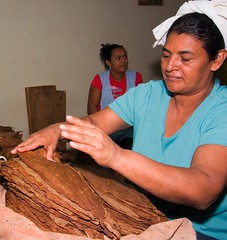
Selecting the Right Leaves
At the next stop in a further sorting and selecting room the tour rather fell apart as the entire labouring team, led by some bolder women, lost all shyness to become entranced by my hair. Much fondling and many questions later, the tour dynamic was never quite as disciplined a group as before!

Hair is their interest
The cigar rolling room was the most amazing and exciting part of the process
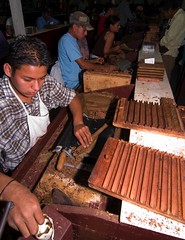
Hand-Rolled Express
Long benches and tables reminiscent of a school science lab, with a big press at each side and dozens of teams of two people hand rolling and hand wrapping each cigar. The A team were definitely on the front row, and at a guess I would say the chubby guy at the far left to the front row was MR PURO! He rolled the biggest cigars with the greatest focused ease of anyone in the room. Real Grouchos... destined for Russian mafia and type A personality clubbable men, perhaps?

Mr Puro
Every rolled cigar is fitted to the appropriate sized mould and stacks of moulds are pressed for 2-5 minutes each way up before being hand wrapped in the selected casing leaf or leaves.
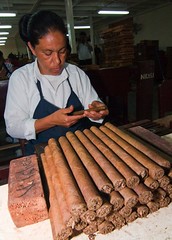
Finishing the Cigar
Newspaper wrapped groups of 100 cigars are labelled with the date, shape type, overall style, tobacco mix used and a code for who produced them and them taken to the drying room for at least 6 months.

The Store of Smokes
We didn’t ask about salaries for the leaf sorters, but the rollers are the crème de la crème, earning between 20 and 27 cordobas each person of a team of two per 100 rolled. The difference in payment reflects the difference in the level of skill. A team of two rolls 500 or 600 cigars per day. 100 cordobas is a little over US$5, 150 cordobas, would be about 4GBP. I am certain that MR PURO was on 27 cordobas per 100!
Every client has its own tobacco mix, and so each cigar rolled already has its destination. Beyond that there are dozens of variations according to wrapping leaf, colour, shape, size, etc.
The quality control man wears an apron and walks between the rows visiting each team and selecting a few cigars at random, pricking a hole and drawing on the unlit cigar to get a sense of the smoking quality this team is producing currently.
Packaging
Those fancy cigars people buy? Each size shape and style is sold by this maker at the same price to the client. It is the client who decides the mark up and, believe me, it is hefty! Perhaps, as scientists have recently demonstrated with regards to wine, the more we pay for a luxury product the more we enjoy it. I don’t think this is a demonstration of gullibility, snobbishness or stupidity, more a demonstration of the power of directing attention. I suspect that the more attention we direct to a sensation, the more subtly we are able to appreciate it and the more there is to appreciate.
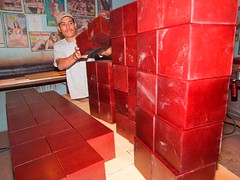
Boxing.
He is so focused on his work he really doesn't need the wall of diversions behind him.
Inside the compound, a team of woodworkers create many shapes, sizes and colours of cigar box for the many international clients this factory serves. Brands are added by carving, pokerwork or adhesive labels.
The women(for they are all women) who package the cigars earn differently according to their role.
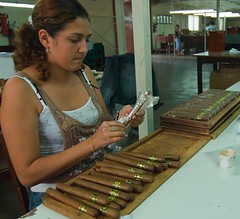
Packing
Those who stick the ring label around each cigar individually by hand, package each cigar in cellophane and stack them in the overall wrappings earn 2 cordobas per 25 completed cigars. Each ahs one of those roles and each gets the 2 cordobas per 25. 2 cordobas is about ten cents US or slightly over 1 penny sterling.
The women who stuff the boxes, label them and iron on the skin-tight cellophane wraps are paid a 60 cordoba day rate, US$3, 7.30 to 4.30 am, with an hour for lunch and a half hour for breakfast, food not included.
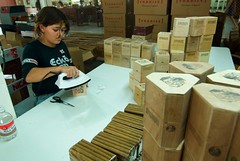
Iron Seal
We questioned the use of labels declaring ‘Handmade in Honduras’. The manager shrugged: ‘The client sends the packaging they want used and we use it.’!
It was a great morning. If you get the chance, go some day.



No comments:
Post a Comment